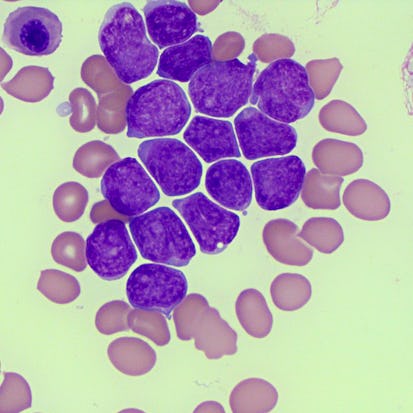- Level Professional
- المدة 35 ساعات hours
- الطبع بواسطة University of Western Australia
-
Offered by

عن
This is a unique online course which teaches students the basics of blood film analysis. This course is specifically tailored to those with a background in Medical Science, Medicine or Pathology who are studying or starting work in a haematology laboratory but also serves as a valuable continuing education resource. To be successful in this course, access to a haematology laboratory is desirable but not essential. This is not a textbook or a laborious examination of every blood film abnormality but rather focusses on the approach " both an overall method for analysing a blood film, and a framework for analysing quantitative and qualitative changes in blood cells. At each step students are taught a method, provided with the theoretical framework for interpreting abnormalities, and shown examples of abnormalities highlighting their clinical significance. This is reinforced with frequent in-lecture interactive quizzes, end of lecture mcqs, and suggested lab exercises which engage the student with the laboratory and their colleagues. At the end of each module and at the end of the whole series are summative assessments which must be successfully completed to attain the course certificate.الوحدات
1.1 Course Overview
1
Discussions
- Tell your supervisor or a senior lab colleague that you are undertaking this course.
3
Videos
- Welcome Video and Course Outline
- Importance of Learning a Method for Blood Film Analysis
- An exemplar of the systematic framework for blood film interpretation
1.2 The Analyser
1
Assignment
- End of 1.2 Quiz
1
Peer Review
- Practical Learning Activity 1.2
9
Videos
- Reason/s for using an analyser
- The value and limitations of an analyser
- How the analyser works (counting & sorting)
- Analyser parameters (Red cell)
- Special red cell parameters (RDW, Reticulocytes, Hb)
- Analyser parameters (White cell)
- Analyser parameters (Platelets)
- Analyser errors (Red cell)
- Analyser Errors (White Cell & Platelets)
1.3 Importance of Making a Blood Film
6
Videos
- Indications for making a blood film
- Importance of making a good film
- Pre-analytical Step 1 - Collecting the blood
- Pre-analytical Step 2 - Spreading the film
- Pre-analytical Step 3 - Preparing the slide
- Identifying and fixing staining problems
1.4 A methodical approach to blood film analysis
1
Peer Review
- Practical Learning Activity 1.4
5
Videos
- Looking at a blood film
- Analyzing the blood film methodically
- Analyzing red cells
- Analyzing white cells
- Analyzing platelets & film comment
End of 'Course Introduction' Module 1
1
Assignment
- End of Module 1 Quiz
1
Readings
- Supplementary Readings for Module 1
2.1 Red Cell Morphology Basics
1
Peer Review
- Practical Learning Activity 2.1
5
Videos
- Overview of Red Cell Morphology Basics
- Agglutination
- Rouleaux
- Nucleated red blood cells & Polychromasia
- Red Cells Size
2.2 Describing Microcytic, Macrocytic and Normocytic Anaemias in blood films
1
Assignment
- End 2.2 Quiz
1
Peer Review
- Practical Learning Activity 2.2
6
Videos
- Microcytic Anaemia: Iron Deficiency
- Microcytic Anaemia: Haemoglobinopathies
- Macrocytic Anaemia: Megaloblastic
- Macrocytic Anaemia: Non-Megaloblastic
- Dimorphic Red Cells
- Normocytic Anaemia - including Haemolysis
2.3 Recognising and describing common poikilocoytes
1
Assignment
- End of 2.3 Quiz
7
Videos
- Introduction to poikilocytes
- Spherocytes
- Elliptocytes
- Teardrops & Echinocytes
- Acanthocytes, Targets & Stomatocytes
- Pathognemonic Poikilocytes
- Poikilocytes in action
2.4 Recognising and describing red cell inclusion
4
Videos
- Introduction to red cell inclusions
- Howell Jolly Bodies & Hyposplenic Films
- Basophilic Stippling & Pappenheimer Bodies
- Summary
End of 'Red Cell Morphology' Module 2
1
Assignment
- End of Module 2 Quiz
1
Readings
- Supplementary Readings for Module 2
3.1 A framework for analysing white cell quantitative disorders
1
Assignment
- End of 3.1 Quiz
1
Peer Review
- Practical Learning Activity 3.1
9
Videos
- Review of white cell morphology
- Framework for leukocytosis
- Neutrophilia
- Neutrophilia in bone marrow disorders
- Neutropenia
- Lymphocytosis
- Eosinophilia
- Monocytosis
- Basophilia
3.2 Analyzing an abnormal leukocyte population
1
Peer Review
- Practical Learning Activity 3.2
7
Videos
- Introducing the methodical approach - 9 Parameters
- Parameter 1 - Pleomorphic or Monomorphic (Same or Different)
- Parameter 2 - Size
- Parameter 3 - N/C Ratio
- Parameters 4 - 6: Nucleus
- Parameters 7 - 8: Cytoplasm
- Parameter 9: Company the cells keep
3.3 Analysing lymphoproliferative disorders
1
Assignment
- End of 3.3 Quiz
7
Videos
- Grouping lymphoproliferative diseases
- Group 1 - Small, mature lymphocytes
- Group 2 - Mature lymphocytes with cytoplasmic projections
- Group 3 - Cells with eccentric cytoplasm
- Group 4 - Large cells lymphomas
- Group 5 - T cells lymphoproliferative disorders
- Group 6 - NK cells lymphopreliferative disorders
3.4 Analysing acute leukaemias
1
Peer Review
- Practical Learning Activity 3.4
4
Videos
- Steps to analysing acute leukaemia
- Step 1 - Is it acute leukaemia?
- Step 2 - Is it APML?
- Step 3 - What type of acute leukaemia is it?
3.5 Examining qualitative changes in white cells
1
Assignment
- End of 3.5 Quiz
4
Videos
- Lymphocytes
- Neutrophils
- Monocytes
- Myelodysplasia
End of 'White Cell Morphology' Module 3
1
Assignment
- End of Module 3 Quiz
1
Readings
- Supplementary Readings for Module 3
4.1 Platelets (Thrombocytopenia & Thrombocytosis)
1
Assignment
- End of 4.1 Quiz
1
Peer Review
- Practical Learning Activity 4.1
4
Videos
- Thrombocytopenia - Approach
- Thrombocytopenia - Examples
- Thrombocytosis
- Platelet quality
4.2 Pregnancy
1
Assignment
- End of 4.2 Quiz
1
Peer Review
- Practical Learning Activity 4.2
2
Videos
- Changes in a normal pregnancy
- Pathology in pregnancy
4.3 Paediatrics
1
Peer Review
- Practical Learning Activity 4.3
5
Videos
- Normal ranges in children
- Pathology: Anaemia
- Pathology: Thrombocytopenia
- Pathology: Pancytopenia
- Pathology: Leukocytosis
4.4 Parasites
1
Peer Review
- Practical Learning Activity 4.4
8
Videos
- The Scale of Malaria
- The lifecycle of parasites
- Film staining and terminology
- P Falciparum
- P Vivax
- P Ovale
- P Malariae
- An Approach to Malaria Diagnosis
End of '4Ps of Morphology - Platelets, Pregnancy, Paediatrics and Parasites' Module 4
1
Assignment
- End of Module 4 Quiz
1
Readings
- Supplementary Readings for Module 4
Case Study 1 - 5
7
Videos
- Prologue to Case Studies
- Case 1 - Microcytic anaemia
- Case 2 - Anaemia and thrombocytopenia
- Case 3 - Lymphocytosis
- Case 4 - Acute leukaemia
- Case 5 - Pancytopenia
- Epilogue to Case Studies
1
Readings
- Bonus Case Study 6 and 7
End of Whole Course
1
Assignment
- End of Whole Course Quiz
1
Videos
- End of Course Video
Auto Summary
"Blood Film Morphology - A Practical Guide" is an engaging online course offered by Coursera, designed for those in Medical Science, Medicine, or Pathology fields. Focusing on blood film analysis, it provides practical methods and theoretical frameworks for interpreting abnormalities. The course includes interactive quizzes, lab exercises, and summative assessments for certification. With a duration of 2100 minutes, it offers Starter, Professional, and Paid subscription options, making it ideal for both beginners and professionals in haematology.

Matthew Wright

